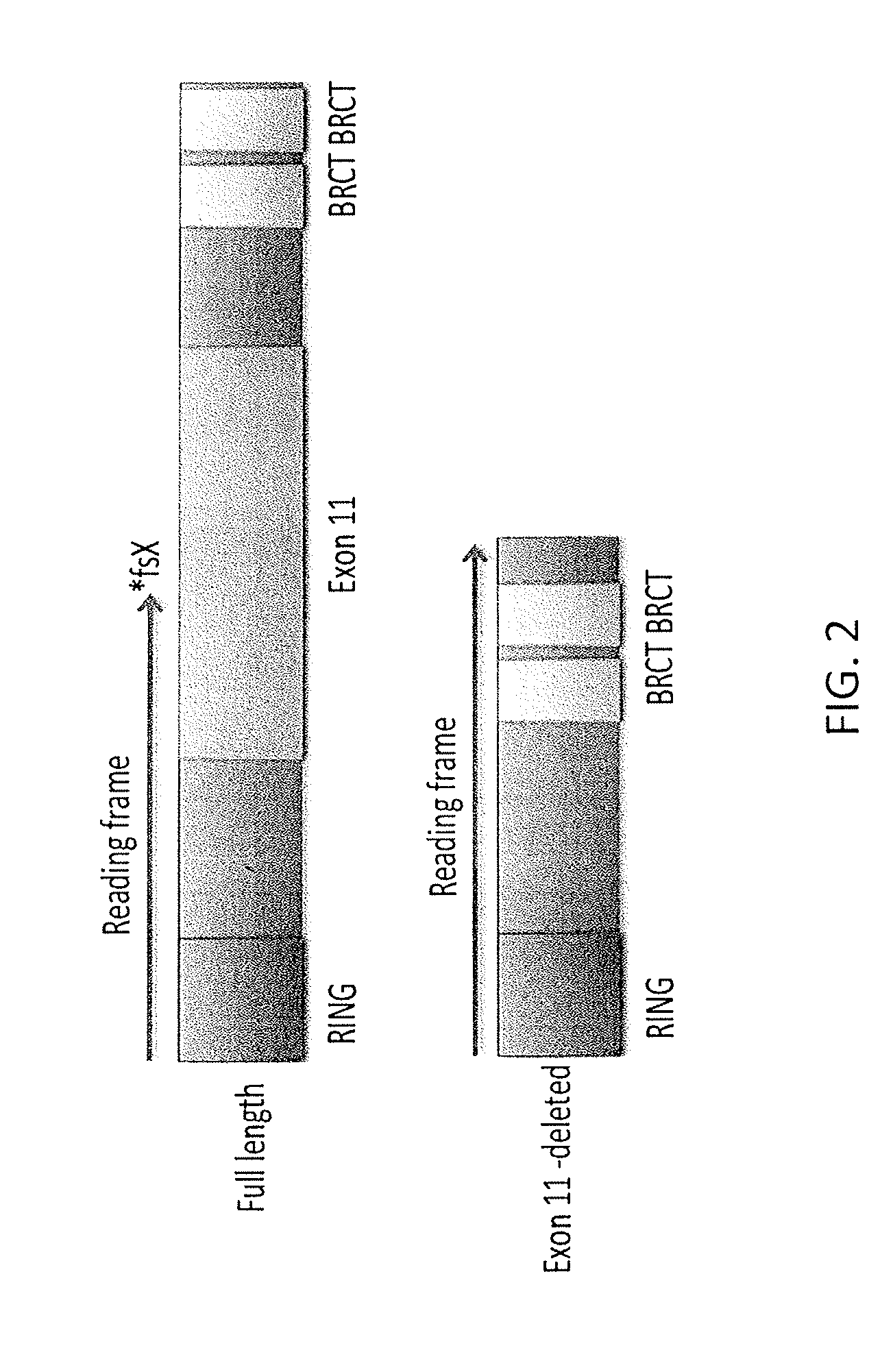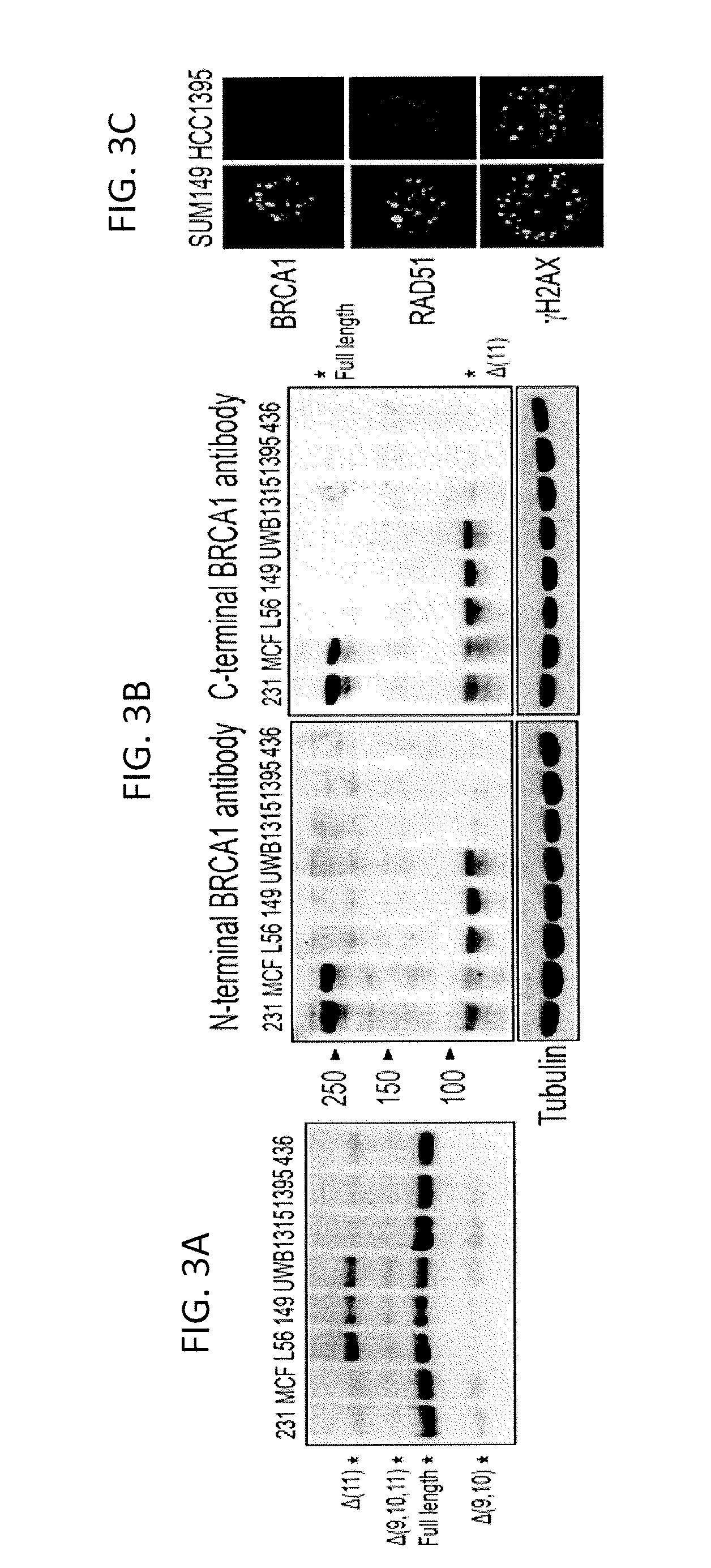Methods for determining parp inhibitor and platinum resistance in cancer therapy
- Summary
- Abstract
- Description
- Claims
- Application Information
AI Technical Summary
Benefits of technology
Problems solved by technology
Method used
Image
Examples
example 1
Preliminary Studies
[0059]Both human and mouse cells express an alternatively spliced in-frame variant referred to as BRCA1-Δ11, lacking most or all of exon 11. Mice bearing mammary-specific deletions of exon 11 develop mammary adenocarcinomas with chromosomal instability and are sensitive to PARP inhibitor treatment. However, murine embryos bearing targeted mutations that selectively abolish expression of full-length Brca1, while leaving Brca1-Δ11 expression intact, survive significantly longer than mice expressing targeted mutations that abolish expression of both Brca1 and Brca1-Δ11. Additionally, cells expressing Brca1-Δ11 are able to form residual Brca1 and Rad51 foci. Without intending to be limited to any particular theory or mechanism of action, it is believed that Brca1-Δ11 is able to partially compensate for loss of full-length Brca1. To date, the role of BRCA1 isoforms in the development of platinum or PARP inhibitor resistance has not been addressed. These experiments inv...
example 2
Identification of BRCA1 Isoforms that are Highly Expressed in Drug Resistant Tumors
[0068]It is believed that in-frame splicing has the potential to remove deleterious exons from the mature mRNA to extend the reading frame through to the C-terminus. Studies in PDX BRCA1 mutant models suggest that multiple exons may be removed in drug resistant tumors (FIG. 6B), and that tumors may produce a more diverse range of splice variants in comparison to cell lines. Furthermore, it is not known if splicing of deleterious exons occurs only in exon 11 BRCA1 mutant tumors or if this mechanism of resistance is more general and applicable to other mutation types.
[0069]Experimental Methods. The mRNA and peptide sequence, as well as the expression levels of BRCA1 splice variants in mutant PDX and primary patient tumors, will be assessed and confirmed under IRB approved protocols. BRCA1 mutant tumors will be obtained from three sources so that sufficient numbers can be analyzed for variant expression....
example 3
Characterization of the Ability of BRCA1 Isoforms to Provide HR DNA Repair and Drug Resistance
[0074]The experiments from Example 2 will establish cell lines over-expressing novel BRCA1 variants. The following experiments will determine if variants contribute to HR DNA repair and therapy resistance.
[0075]Experimental Methods. MDA-MB-436 cells were found not to form detectable BRCA1 or RAD51 foci under any experimental conditions tested. However, the addition of wild-type BRCA1 add-back restores BRCA1 and RAD51 focus formation.
[0076]First, the ability of variants to restore BRCA1 and RAD51 focus formation will be evaluated, and compared to empty vector and wild-type BRCA1 add-back cell lines. Cells will be treated with 10 Gy γ-irradiation (IR) or 1 μM rucaparib and BRCA1 and RAD51 foci formation measured at multiple time points post-treatment by immunofluorescence. Cells will be fixed and stained with respective antibodies followed by fluorescent conjugated secondary antibodies and DA...
PUM
| Property | Measurement | Unit |
|---|---|---|
| Structure | aaaaa | aaaaa |
| Electrical resistance | aaaaa | aaaaa |
| Nucleic acid sequence | aaaaa | aaaaa |
Abstract
Description
Claims
Application Information
 Login to View More
Login to View More - R&D
- Intellectual Property
- Life Sciences
- Materials
- Tech Scout
- Unparalleled Data Quality
- Higher Quality Content
- 60% Fewer Hallucinations
Browse by: Latest US Patents, China's latest patents, Technical Efficacy Thesaurus, Application Domain, Technology Topic, Popular Technical Reports.
© 2025 PatSnap. All rights reserved.Legal|Privacy policy|Modern Slavery Act Transparency Statement|Sitemap|About US| Contact US: help@patsnap.com



